Despite no family history, my blood pressure is apparently higher than Cheech & Chong. One specialist, upon remarking that I was maybe a millimeter of mercury – maybe less – from stroking out right there on her table, opined that perhaps I am “carrying my stress wrong.”
I carry my stress in a bag. That’s how I’ve always carried it. A messenger bag, with a shoulder strap. And now every headache in my life comes equipped with a flash of fear that maybe I should clean the bathrooms and wipe the porn from my computer, so a family member doesn’t have to do it after my rapidly cooling body is found.
Games like Impire, which causes headaches, do little to ease my mind.
I’ve always intended (though never actually gotten around) to writing about it for this site, but Dungeon Keeper 2 is one of my very favorite games of ever. I’m a little more neutral on the original, but the sequel, man, I love that with all my heart. Alas, it’s one of the least future-proof games I’ve ever encountered; even the GOG optimization is profoundly weak. Bullfrog is long since out of business and despite a few sort of halfhearted attempts to mimic the style, we’ve never seen a game like it.
The two attempts to recreate the feel of Dungeon Keeper 2 that leap to mind are Elixir’s Evil Genius (which even the kindest had to admit was irretrievably flawed) and Realmforge’s Dungeons (which was execrable). For some reason no one has been able to match its magic, despite the fact that the Dungeon Keeper formula is pretty basic. It is, basically, a real-time strategy with a few twists.
So along comes Impire, right on the heels of A Game of Dwarves, both budget titles published by Paradox Interactive; both real-time diggers with a sense of humor, both utterly unable to capture what made Dungeon Keeper 2 such a great game. Of the two, Impire is better made and comes closer, but that’s not saying much.
I’d Rather Take It than Play Most of Their Games
Typically, when gamers see this during a credits screen

they tend to shrivel up a little bit. How Cyanide stays in business when dozens of far better studios die on the vine is beyond me. The Paris- and Montreal-based company has never created a game that’s remotely good, and is responsible for some – like A Game of Thrones (not to be confused with that of Dwarves) – that are veritable crimes against the medium. That Impire is far and away their best game says something pretty damning.
Impire is a management game in which you dig out dungeons, populate them with ferocious beasts, manage economies and upgrades, and pummel your foes, both do-gooder heroes and competing evil overlords. So far so good, right? That’s Dungeon Keeper exactly. In Impire, a sorcerer desperate to earn his evil chops summons the demon Baal-Abaddon to serve his bidding. A screw-up during the incantation transforms Baal; where once had towered a fifteen-foot, flame-wreathed nightmare now stands a midget imp with an attitude problem, and hilarity ensues.
No, really! It does! Impire is actually pretty funny, and it knows that the whole dungeon-keeping concept depends on the silliness of evil. Baal was a demon and now he’s an imp. His summoner is evil, but so incompetent that he can’t make a name for himself. The dialogue and villains are chuckleworthy.
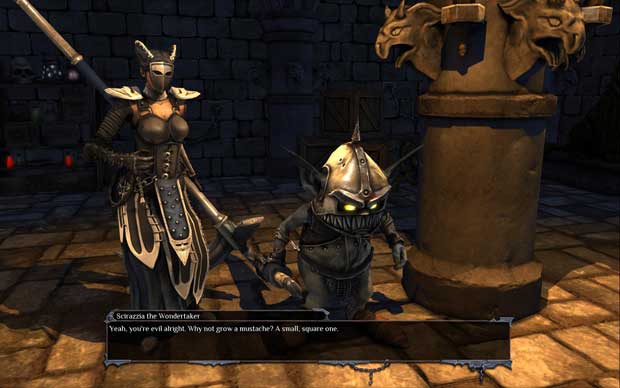
Moreover, what Impire innovates, it innovates well. You summon monsters directly to your dungeon rather than luring them based on the amenities you offer, and then have the opportunity to assign them to squads of four. Squads stick together, patrolling the dungeon and leveling as a unit, which makes planning a lot easier. And you can send squads out to the overworld on raids, to complete objectives, gather treasure, or just cause chaos. Beyond unit management, Impire offers a large selection of rooms to construct, along with traps and dungeon improvements, plus a significant upgrade tree that all but guarantees your unique play style can be accommodated by the game.
In fact, if it weren’t for Impire’s crippling fundamental issues, I’d be recommending it heartily. It’s funny, looks pretty good, runs fine, and adds enough uniqueness to the world of Dungeon Keeper clones that you can’t fully dismiss it as a Dungeon Keeper clone. Sadly Cyanide took its potentially fun game and ruined it through nothing more than its own characteristically mind-boggling ineptitude.
Click “Start,” then “Begin,” then “New Game,” then “Go,” then “Launch,” then “Proceed”
The first warning you get that something’s not right with Impire is the game menu. It makes no sense, jumbling beta multiplayer stuff in with single-player settings, scattering buttons hither and yon, and really going out of its way to be unnecessarily confusing. It took me a good five minutes to figure out for sure that I was actually starting the single player campaign. The menu of Impire is like trying to turn on the television at a mediaphile friend’s house – forty-six remotes, nine inputs, seven devices, and then it’s all in Spanish.
Once in-game, Impire only has two flaws, but they’re doozies: interface and information flow.
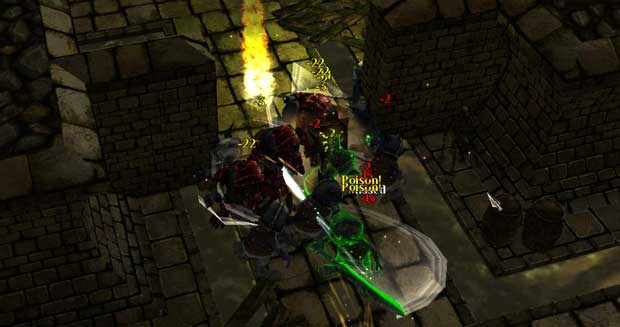
This is combat. If you can tell what’s going on, you’re better than me. I think poison is involved somehow. In case you can’t see, there are also six instances of “-22” (in yellow), three instances of “-2” (in red), “Missed” and something I can’t quite make out. Plus that green thing, whatever that is.
Tooltip-sparse iconic buttons are one thing, but requiring the player to move amongst several different menus to view or accomplish stuff that should be onscreen at all times is unforgivable. Want to review your squads? Gotta go to the Squads Menu. Want to hire new creatures? Gotta go to the Management Menu, or right-click on a monster-producing room… which is often miles away from where you’re looking. Want to build a room or hallway? Back to the Management Menu, which runs in real time but which doesn’t allow you to give any orders other than building. The radial right-click context menus do help with some of the mess, but all in all gameplay of Impire is unnecessarily complex because you don’t have the front and center access to tools and information you need. It’s unintuitive and frustrating, because the interface isn’t hard, it’s just completely obtuse.
Not to mention that some commands simply don’t exist: there’s no way to queue instructions for units or squads, for example. This would be okay if your creatures were better at managing their own daily lives, like the creatures of Dungeon Keeper 2 were. In that game, hungry creatures went to eat on their own. Bored creatures entertained themselves on their own. Newcomers automatically established lairs near creatures they had an affinity for. Workers of all kinds gravitated toward the rooms where they liked to work. The key was building an efficient dungeon, so food or entertainment or lodging were never too far away. You weren’t responsible for micromanaging, you were responsible for making it possible for your creatures to micromanage themselves.
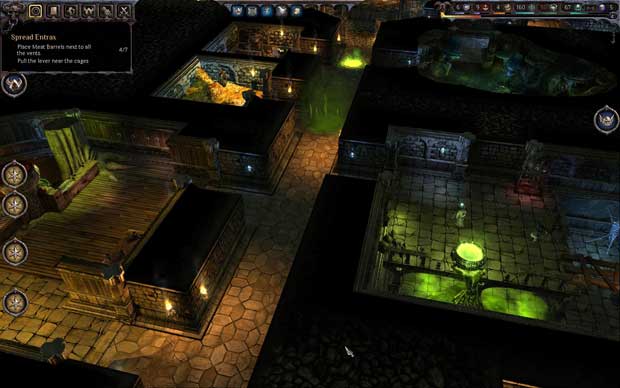
In Impire, you have to tell your creatures to eat. You have to tell them to train. You have to tell them to do everything, and you can only tell them one thing at a time, so it becomes an endless exercise of sending a squad to the kitchen for a meal, then telling it to work out in the training room, then dispatching it on patrol, then teleporting it to the location of invading heroes… and, of course, manually upgrading their equipment on a creature-by-creature basis. The result is that you’re constantly doing little-picture busywork when you should be focusing on the big picture.
Your Dungeon is Full of Yoghurt
The first several missions of Impire act as an hours-long tutorial. Enough control is released early on that this isn’t an irritant, but what Impire doesn’t tell you is as voluminous as what it does. Icons pop up all over the screen, floating nauseatingly as you scroll. Icons for rooms, icons for squads, icons for Baal, icons for objectives. Hovering over them doesn’t reveal what they are, so start memorizing. The narrator will go into agonizing detail about things like the upgrade tree and foe tags without ever actually telling you how to use them, then punish you for looking at a menu screen because the game’s in real time no matter whether you’re in an interface that allows direct control or not.
Other times it’ll pop in with a completely incongruous, never-explained remark like “new ladders have been added to your dungeon.”
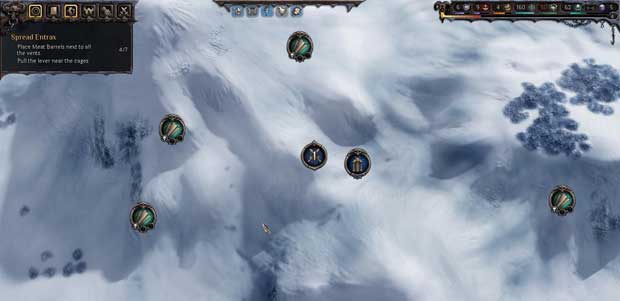
Squad One advances on an Overworld raiding target.
What the crap does that mean?
I know what a ladder is, I know what a dungeon is. I can extrapolate, sure, but… why were new ladders added to my dungeon? I didn’t ask for new ladders. Where are they? What should I do with them? Why don’t you tell me when a squad’s back from a raid, or that they’ve reached their level cap, or that a hero has destroyed my nursery, or that someone is hungry? Why don’t you tell me when a room has no workers, or when an imp is idle, or that I’m low on treasure? Why don’t you tell me when a squad is under attack, or when my prison is full, or when a captive hero’s been killed in the training room? Why don’t you tell me that I’m out of mushrooms, or that a squad’s been destroyed, or that armor upgrades are available? Instead, it’s alerts about ladders.
A special pet peeve of mine with games like this has to do with the digging interface, or lack thereof. Admittedly, Dungeon Keeper 2 was from a simpler time; a tile-based, isometric, one-level view was the best the technology could do, and as such it was pretty logical where you could and couldn’t dig. Connecting rooms was a matter of smashing a hole in the wall and building a corridor. Not so in Impire, where rooms come in pre-fab shapes, with pre-fab entrances. Not so in Impire, where it refuses to allow you to dig tunnels in earth that appears to be perfectly diggable. Not so in Impire, a game that doesn’t even allow you to connect rooms to each other. I guess it’s a toss-up between the gross limitations of Impire’s digging and the unmanageable lunacy of A Game of Dwarves, though I can’t help but think that there’s a simple golden mean in there somewhere. Oh wait! There is! It’s called Dungeon Fucking Keeper 2, which got it right in 1999.
And So We Wait
If Impire were a flat-out bad game I’d be much happier, because that’d be easier. But it’s not. It’s a very well-meaning game, one that’s almost fun, but for itself. When Dungeons came out in 2011, that game was easy to hate. It was terrible. Everything about it was bad. Impire is not the same way at all; it’s not terrible and almost nothing about it is bad. But the tiny handful of things that are sabotage the rest of the experience almost beyond repair.
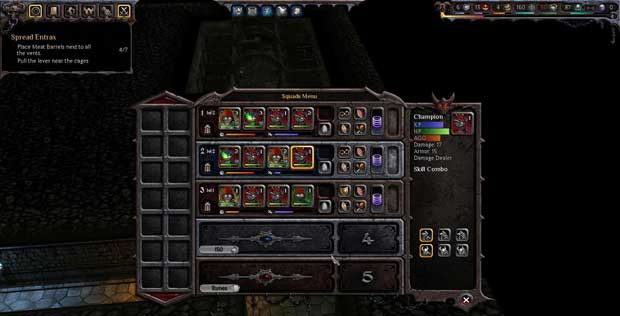
In general I’d say if you’re a Dungeon Keeper obsessive who’s willing to withstand a lot of clumsiness in game design, you might be able to enjoy Impire. As for me… I don’t see myself spending a lot of time with it. It raises my blood pressure. It makes me mad and frustrated, because here’s a game with tons of potential that capitalizes on none of it, and in so doing de-funs itself. Honestly I don’t know if I’ve ever played a game that actually excises its own fun before, but Impire manages. I’d like to play more. I’d like for Impire to be my holdover, my evening go-to until Bioshock Infinite comes out. And I’ll keep trying, at least for a little while, but in my high-pressure heart I don’t think its chances are good.
Thus we dungeoneers who so enjoy their keeping must wait again for a modern take on the old classic. At this point all our hopes are pinned on War for the Overworld, a recent Kickstarter success that’s made no secret of its roots… the team behind it are actively trying to recreate Dungeon Keeper (not Dungeon Keeper 2, but I’ll take what I can get), balls to bones. And good on them, I say. I backed War for the Overworld and I really hope it’s excellent, though a complex game from an untried team, when so many veterans have failed, is a scary proposition.
When the inevitable Steam sale knocks it down to 99% off, Impire will be worth it. But at $19.99, you’re better off leaving that gold in your treasure room.
![]()
Do a great impression of Steerpike – even the ears – at Steerpike@tap-repeatedly.com.


Ah, finally read this, and had a good laugh about it. At least you had some entertaining frustrations.
I’ve never been a big fan of context-free floating numbers.
“I’d rather take it than play most of their games.” Oh you! 🙂
The interface can’t be as bad as Dwarf Fortress’ right? RIGHT? Seriously though, I hate micromanagement. That sort of stuff kills games for me. It killed Homeworld for me. It killed Company of Heroes for me. And they’re considered classics. Dungeon Keeper was great for that because indeed, your denizens micromanaged themselves. In fact, I’ll never forget the time I watched a bile demon slowly making his way to the hatchery instead of staying in the workshop building things. I slapped him to hurry him up and you know what he did? He turned round and went back to work. He just wanted a snack and a break the lazy bastard. There was so much personality in that one moment.
But that’s what I loved about Dungeon Keeper, is the way that I felt like a master looking over his minions, not after them. That’s a massive difference.
I always preferred the original Dungeon Keeper for its bleaker tone. The sequel seemed a bit more whimsical but objectively it was probably the better game. I preferred the interface in DKII as well but I really missed dragons and demon spawn. Attracting those things then seeing them walking around your library was magnificent. I remember the Horned Reaper having a very different role too, although I can’t recall how.
A great review Steerpike, I’ve pointed Luke this way because he’s also a Dungeon Keeper zealot who purchased Dungeons and was eyeing up this.
Heh heh, no, not as bad as Dwarf Fortress.. but a lot more irritating. To DF’s credit, once you learn the controls it’s an easy enough game to play (not that I ever learned the controls). With this, it would have been a fun game had it not been for stupid design mistakes in information management.
My chief complaint about the original Dungeon Keeper was that I had trouble with cause and effect in it. Sometimes things that should’ve happened didn’t (I’d build a nice torture chamber and no Dark Mistresses would enter, for example), and I was never 100% certain that some action I took was going to result in what I intended. Beyond that, it was a fantastic game, ahead of its time in many ways. I too missed the Dragons and Demon Spawn (didn’t the latter evolve into the former at eighth level?) and the way Horned Reapers were managed. You could only get them through sacrifices in your Temple Pool, and they were so dangerous that you needed to put them alone in their own little suite of rooms. I still have the narration memorized…
“Behold… you have summoned forth a Horned Reaper. Try not to make it angry. You’ll fail, because everything makes it angry; so at least try to make sure it’s pointed at the enemy when it finally goes ballistic.”
Definitely, Luke, steer clear of this one for now. Maybe on a big Steam sale. You and I will have to hold out until War for the Overworld, looks like.
Believe it or not the original Dungeon Keeper was the first game ever that dealt me a game-breaking bug… hang on, no it wasn’t, that was Flashback. Anyway. The enemy AI would literally stop working so after an hour or so of amassing a full blown dark army and subsequently invading the enemy dungeon I’d be shocked to find a half-made hatchery, treasury and lair with a few flies, beetles, imps and other low level creatures bumbling about vacantly. It was a massive disappointment. I remember spending ages on the phone with Bullfrog (no internet back then) trying to get this sorted (and I was a young lad too). They sent me some patch disks in the post which I then had to access IN DOS USING PKUNZIP. What the fuck was pkunzip? I never did get Dungeon Keeper working again after that. It was the most addictive game I’d ever got blissfully lost in and it was a game-breaking bug that yanked me right out of it. So disappointing. So yeah, I can understand the apparent bugs or inconsistencies you encountered.
The demon spawn did grow into dragons yeah, and man, it took a long time to get them to that level.
Yes! That was it with the Horned Reaper! He was so absurdly powerful, temperamental and easy to anger that you had to be 100% sure you could handle him if he was summoned. What a great idea for a ‘minion’.
i feel i have to write a comment know as you keep talking about me lol.
first of all what a great write up Mr Steerpike sir. i will be sure to follow your advice and wait for a steam sale before going in and grabbing Impire. that said i think it will be some time before the put it on a 99% sale.
i loved no LOVE dungeon keeper 1 and 2. i have to say that 2 was better for me. the graphics were more polished and i loved the extra dungeon building missions you could do on the side. you remember the ones that were not part of the campaign. i would spend hours on end playing through those maps until i like you Gregg i got a bug that i could not fix.
i have looked on so many forums and everyone is crying out for a dungeon keeper 3 type game that picks up where the first 2 left off. why is it that so far no developer has managed to come up with this, it seems so simple. hey just buy the rights to the first 2, update them both a little and re-release them. i will be front of the queue to buy them.
i will wait with much anticipation for the release of war for the overworld and really hope that it does not turn out to be yet another let down like so many have been before. don’t get me started on bloody Dungeon’s. biggest waste of money ever. actually that medal would go to Arma 2 but Dungeons is a very close second place. never has a game promised so much and delivered oh so very very little.
unfortunately my expectations are not to high for overworld due to all the past let downs, however at least they are making it clear that there goal is to take the mantle from the other Dungeon keeper games and continue with them.
here’s wishing we all get what we have been waiting so long for when it is released.
Hey Luke!
You’re right. The Dungeon Keeper formula doesn’t seem that hard. Why has every effort to recreate it failed?
Partly I think it’s because developers don’t want to “just” remake DK. They want to add their own stamp. This inevitably gets them into trouble; and it’s why I have high hopes for War for the Overworld: they have no illusions. They’re trying to make a new DK game in all but title.
Typically, these games fall apart in controls and interface. Certainly that’s the case with Evil Genius, Impire, and Game of Dwarves – too much information, not well handled. DK2 had perfect information management. I could see all my creatures, sort them by happy/ambivalent/angry, keep an eye on all relevant counters without leaving the main screen, and easily change my view to any dungeon location or camera position. That, plus the Possess Creature power, made it a joy to control, so you could focus on your dungeon keeping.
Gregg’s story about his Bile Demon is also important. The creatures took care of themselves; you took care of the dungeon. I haven’t yet seen a game that emulates that. (also: PKUnzip! Wow, that brings memories)
Dungeons was so terrible I uninstalled it after only two hours. A pity since I’d been looking forward to that game. Of all these bad games, it was by far the worst.
I’ve given up on Impire, and I strongly reiterate my position that you not buy it unless the Steam sale is so cheap that it’d be irresponsible not to.
Given the history of attempts to renovate the dungeon, perhaps we should be assidiously avoiding anything resembling game development. Clearly, everyone who loves Dungeon Keeper 2 is an utter failure at making games inspired by it.
Another quiet disappointment, but after Dungeons I wasn’t expecting much more from this.
Fortunately for me, Dungeon Keeper 2 works well, aside from a sluggish main menu. It’s just a pity I’ve finished the campaign three times over the years and can’t bear to go back to it – while the skirmish AI is far from impressive.
Would you happen to know if GoG got the multiplayer working well?
Oh, small correction/addition: When the original developers themselves decided to launch the dungeon into space, they achieved the only management game I feel surpasses DKII – Startopia!
I hope Mucky Foot is resting in peace, while its components await the worms to be reprocessed into new gaming goodness. It has only been twelve years, after all ;-;
I really liked Startopia, but I didn’t like it half as much as DK2. It had many, many good ideas, though. Very fun and sweet-natured. I think that one still runs okay on modern Windows, too.
Don’t know about the multiplayer through GoG, Jakkar. For me, in single player, I can’t get the mouse cursor to bind to the window (so whenever I mouse too far to the right I wind up on my second monitor’s desktop); I can’t get it to play nice with a 16:10 monitor ratio, I can’t get the sound to play reliably, and it ignores my efforts to remap keys. So not unplayable, but a big pain. I should see if GoG has patched it, though, because they do that from time to time.
I wonder what would happen if I set up an XP or Win98 virtual machine and tried it in there. I have VMWare. Sound Blaster emulation might be an issue, but I bet I could emulate everything else in software. What was DK2? DirectX 6? I think it was DirectX 6. Maybe 7. I should look into that.
Ah, the pitfalls of technology. I sort of past-proof myself by sticking to a traditional aspect ratio 1280×1024 resolution LCD monitor – looks pretty at its size, sufficient for watching films, while running modern games like a dream due to the lower-than-average resolution, jaggy-free with just a 2x-4x AA pass. Going widescreen is one of the cruellest things you can do to a less-than top-of-the-line GPU.
On the other hand, I have to play Bioshock barely able to see more than Isaac’s right ear and shoulder, with a disturbingly narrow view of the gameworld – certain console ports were evidently never tested on anything but widescreen televisions, and the FOV suffers.
I suspect I’ve unknowingly bypassed a lot of issues with older games by using resolutions and aspect ratios they were programmed for even all those years ago.